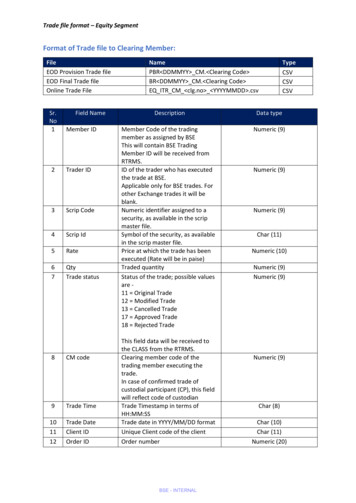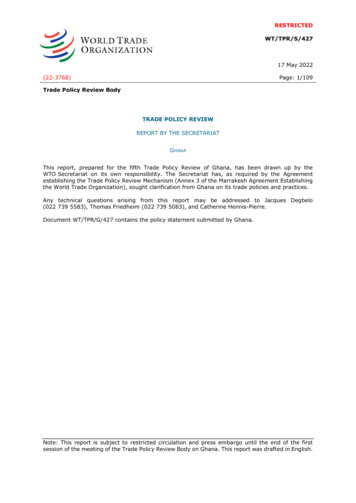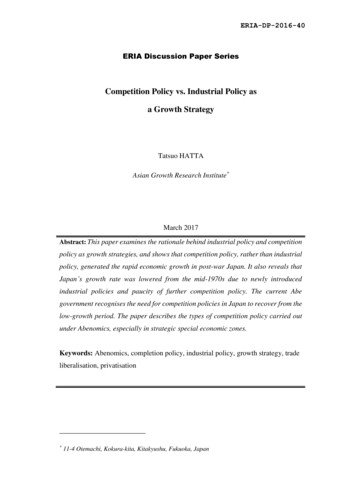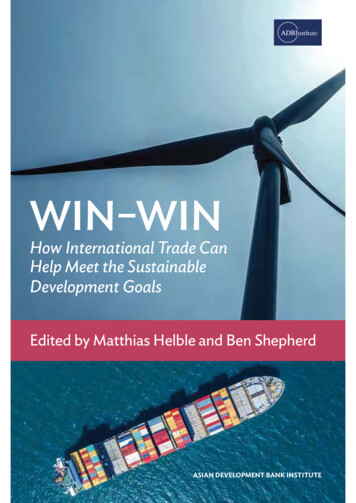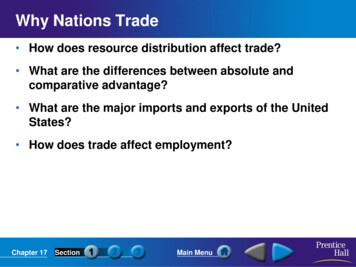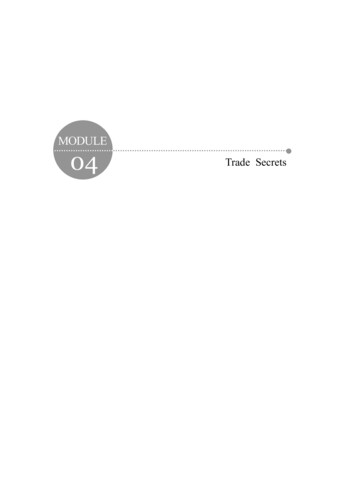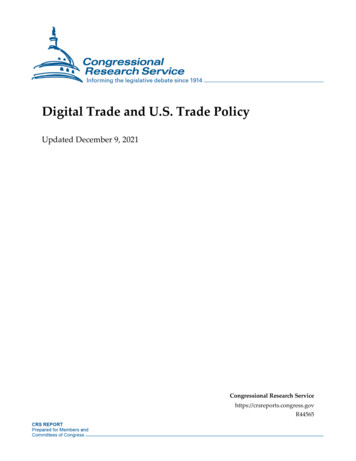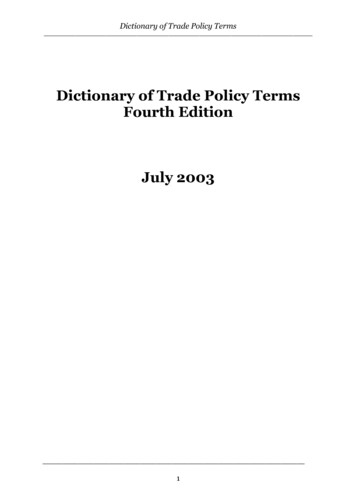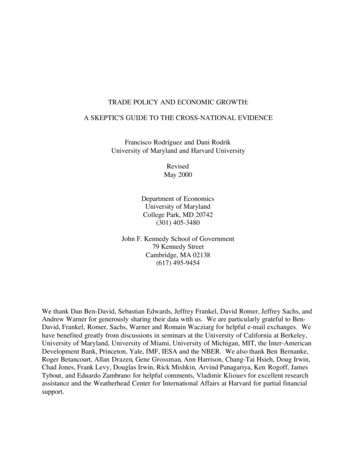
Transcription
TRADE POLICY AND ECONOMIC GROWTH:A SKEPTIC'S GUIDE TO THE CROSS-NATIONAL EVIDENCEFrancisco Rodríguez and Dani RodrikUniversity of Maryland and Harvard UniversityRevisedMay 2000Department of EconomicsUniversity of MarylandCollege Park, MD 20742(301) 405-3480John F. Kennedy School of Government79 Kennedy StreetCambridge, MA 02138(617) 495-9454We thank Dan Ben-David, Sebastian Edwards, Jeffrey Frankel, David Romer, Jeffrey Sachs, andAndrew Warner for generously sharing their data with us. We are particularly grateful to BenDavid, Frankel, Romer, Sachs, Warner and Romain Wacziarg for helpful e-mail exchanges. Wehave benefited greatly from discussions in seminars at the University of California at Berkeley,University of Maryland, University of Miami, University of Michigan, MIT, the Inter-AmericanDevelopment Bank, Princeton, Yale, IMF, IESA and the NBER. We also thank Ben Bernanke,Roger Betancourt, Allan Drazen, Gene Grossman, Ann Harrison, Chang-Tai Hsieh, Doug Irwin,Chad Jones, Frank Levy, Douglas Irwin, Rick Mishkin, Arvind Panagariya, Ken Rogoff, JamesTybout, and Eduardo Zambrano for helpful comments, Vladimir Kliouev for excellent researchassistance and the Weatherhead Center for International Affairs at Harvard for partial financialsupport.
TRADE POLICY AND ECONOMIC GROWTH:A SKEPTIC'S GUIDE TO THE CROSS-NATIONAL EVIDENCEABSTRACTDo countries with lower policy-induced barriers to international trade grow faster, once otherrelevant country characteristics are controlled for? There exists a large empirical literatureproviding an affirmative answer to this question. We argue that methodological problems withthe empirical strategies employed in this literature leave the results open to diverseinterpretations. In many cases, the indicators of "openness" used by researchers are poormeasures of trade barriers or are highly correlated with other sources of bad economicperformance. In other cases, the methods used to ascertain the link between trade policy andgrowth have serious shortcomings. Papers that we review include Dollar (1992), Ben-David(1993), Sachs and Warner (1995), Edwards (1998), and Frankel and Romer (1999). We findlittle evidence that open trade policies--in the sense of lower tariff and non-tariff barriers totrade--are significantly associated with economic growth.Francisco RodríguezDepartment of EconomicsUniversity of MarylandCollege Park, MD 20742Phone: (301) 405-3480Fax: (301) 405-3542Dani RodrikJohn F. Kennedy School of GovernmentHarvard University79 Kennedy StreetCambridge, MA 02138Phone: (617) 495-9454Fax: (617) 496-5747
TRADE POLICY AND ECONOMIC GROWTH:A SKEPTIC'S GUIDE TO THE CROSS-NATIONAL EVIDENCE"It isn't what we don't know that kills us. It's what we know that ain't so."-- Mark TwainI. IntroductionDo countries with lower barriers to international trade experience faster economicprogress? Few questions have been more vigorously debated in the history of economic thought,and none is more central to the vast literature on trade and development.The prevailing view in policy circles in North America and Europe is that recenteconomic history provides a conclusive answer in the affirmative. Multilateral institutions suchas the World Bank, IMF, and the OECD regularly promulgate advice predicated on the beliefthat openness generates predictable and positive consequences for growth. A recent report bythe OECD (1998, 36) states: “More open and outward-oriented economies consistentlyoutperform countries with restrictive trade and [foreign] investment regimes.” According to theIMF (1997, 84): “Policies toward foreign trade are among the more important factors promotingeconomic growth and convergence in developing countries."This view is widespread in the economics profession as well. Krueger (1998, 1513), forexample, judges that it is straightforward to demonstrate empirically the superior growthperformance of countries with "outer-oriented" trade strategies. According to Stiglitz (1998, 36),"[m]ost specifications of empirical growth regressions find that some indicator of externalopenness--whether trade ratios or indices of price distortions or average tariff level--is stronglyassociated with per-capita income growth." According to Fischer (2000), "[i]ntegration into theworld economy is the best way for countries to grow."
2Such statements notwithstanding, if there is an inverse relationship between trade barriersand economic growth, it is not one that immediately stands out in the data. See for exampleFigure I.1. The figure displays the (partial) associations over the 1975-1994 period between thegrowth rate of per-capita GDP and two measures of trade restrictions. The first measure is anaverage tariff rate, calculated by dividing total import duties by the volume of imports. Thesecond is a coverage ratio for non-tariff barriers to trade. 1 The figures show the relationshipbetween these measures and growth after controlling for levels of initial income and secondaryeducation. In both cases, the slope of the relationship is only slightly negative and nowhere nearstatistical significance. This finding is not atypical. Simple measures of trade barriers tend notto enter significantly in well-specified growth regressions, regardless of time periods, subsamples, or the conditioning variables employed.Of course, neither of the two measures used above is a perfect indicator of traderestrictions. Simple tariff averages underweight high tariff rates because the correspondingimport levels tend to be low. Such averages are also poor proxies for overall trade restrictionswhen tariff and non-tariff barriers are substitutes. As for the non-tariff coverage ratios, they donot do a good job of discriminating between barriers that are highly restrictive and barriers withlittle effect. And conceptual flaws aside, both indicators are clearly measured with some error(due to smuggling, weaknesses in the underlying data, coding problems, etc.).In part because of concerns related to data quality, the recent literature on openness andgrowth has resorted to more creative empirical strategies. These strategies include: (a)constructing alternative indicators of openness (Dollar 1992; Sachs and Warner 1995); (b) testingrobustness by using a wide range of measures of openness, including subjective indicators1Data for the first measure come from the World Bank's World Development Indicators 1998. The second is takenfrom Barro and Lee (1994), and is based on UNCTAD compilations.
3(Edwards 1992, 1998); and (c) comparing convergence experience among groups of liberalizingand non-liberalizing countries (Ben-David 1993). This recent round of empirical research isgenerally credited for having yielded stronger and more convincing results on the beneficialconsequences of openness than the previous, largely case-based literature. Indeed, thecumulative evidence that has emerged from such studies provides the foundation for thepreviously-noted consensus on the growth-promoting effects of trade openness. The frequencywith which these studies are cited in international economics textbooks and in policy discussionsis one indicator of the influence that they have exerted.Our goal in this paper is to scrutinize this new generation of research. We do so byfocussing on what the existing literature has to say on the following question: Do countries withlower policy-induced barriers to international trade grow faster, once other relevant countrycharacteristics are controlled for? We take this to be the central question of policy relevance inthis area. To the extent that the empirical literature demonstrates a positive causal link fromopenness to growth, the main operational implication is that governments should dismantle theirbarriers to trade. Therefore, it is critical to ask how well the evidence supports the presumptionthat doing so would raise growth rates.Note that this question differs from an alternative one we could have asked: Doesinternational trade raise growth rates of income? This is a related, but conceptually distinctquestion. Trade policies do affect the volume of trade, of course. But there is no strong reasonto expect their effect on growth to be quantitatively (or even qualitatively) similar to theconsequences of changes in trade volumes that arise from, say, reductions in transport costs orincreases in world demand. To the extent that trade restrictions represent policy responses to realor perceived market imperfections or, at the other extreme, are mechanisms for rent-extraction,
4they will work differently from natural or geographical barriers to trade and other exogenousdeterminants. Frankel and Romer (1999) recognize this point in their recent paper on therelationship between trade volumes and income levels. These authors use the geographicalcomponent of trade volumes as an instrument to identify the effects of trade on income levels.They appropriately caution that their results cannot be directly applied to the effects of tradepolicies.From an operational standpoint, it is clear that the relevant question is the one having todo with the consequences of trade policies rather than trade volumes. Hence we focus on therecent empirical literature that attempts to measure the effect of trade policies. Our main findingis that this literature is largely uninformative regarding the question we posed above. There is asignificant gap between the message that the consumers of this literature have derived and the"facts" that the literature has actually demonstrated. The gap emerges from a number of factors.In many cases, the indicators of "openness" used by researchers are problematic as measures oftrade barriers or are highly correlated with other sources of poor economic performance. In othercases, the empirical strategies used to ascertain the link between trade policy and growth haveserious shortcomings, the removal of which results in significantly weaker findings.The literature on openness and growth through the late 1980s was usefully surveyed in apaper by Edwards (1993). This survey covered detailed multi-country analyses (such as Little etal. 1970 and Balassa 1971) as well as cross-country econometric studies (such as Feder 1983,Balassa 1985, and Esfahani 1991). Most of the cross-national econometric research that wasavailable up to that point focussed on the relationship between exports and growth, and not ontrade policy and growth. Edwards' evaluation of this literature was largely negative (1993,1389):
5[M]uch of the cross-country regression based studies have been plagued by empirical andconceptual shortcomings. The theoretical frameworks used have been increasinglysimplistic, failing to address important questions such as the exact mechanism throughwhich export expansion affects GDP growth, and ignoring potential determinants ofgrowth such as educational attainment. Also, many papers have been characterized by alack of care in dealing with issues related to endogeneity and measurement errors. All ofthis has resulted, in many cases, in unconvincing results whose fragility has been exposedby subsequent work.Edwards argued that such weaknesses had reduced the policy impact of the cross-nationaleconometric research covered in his review.Our paper picks up where Edwards' survey left off. We focus on a number of empiricalpapers that either were not included in or have appeared since that survey. Judging by thenumber of citations in publications by governmental and multilateral institutions and intextbooks, this recent round of empirical research has been considerably more influential inpolicy and academic circles. 2 Our detailed analysis covers the four papers that are probably thebest known in the field: Dollar (1992), Sachs and Warner (1995), Ben-David (1993), andEdwards (1998). We also include an analysis of Frankel and Romer (1999), and shorterdiscussions of Lee (1993), Harrison (1996), and Wacziarg (1998).2We gave examples of citations from international institutions above. Here are some examples from recenttextbooks. Yarbrough and Yarbrough (2000, 19) write "[o]n the trade-growth connection, the empirical evidence isclear that countries with open markets experience faster growth," citing Edwards (1998). Caves, Frankel and Jones(1999, 256-257) warn that "[r]esearch testing this proposition is not unanimous" but then continue to say"productivity growth does seem to increase with openness to the international economy and freedom from priceand allocative distortions in the domestic economy," citing Sachs and Warner (1995) and Dollar (1992). Husted andMelvin (1997) cite Ben-David (1993) in support of the FPE theorem (p. 111) and Sachs and Warner (1995) insupport of the statement that "[o]nly a few countries have followed outward-oriented development strategies forextensive periods of time, but those that have done so have been very successful" (p. 287). Krugman and Obstfeld(1997, 260) write that by the late 1980s "[s]tatistical evidence appeared to suggest that developing countries that
6A few words about the selection of papers. The paper by Dollar (1992) was not reviewedin Edwards' survey, perhaps because it had only recently been published. We include it heresince it is, by our count, the most heavily cited empirical paper on the link between openness andgrowth. Sachs and Warner (1995) is a close second, and the index of "openness" constructedtherein has now been widely used in the cross-national research on growth. 3 The other twopapers are also well known, but in these cases our decision was based less on citation counts thanon the fact that they are representative of different types of methodologies. Ben-David (1993)considers income convergence in countries that have integrated with each other (such as theEuropean Community countries). Edwards (1998) undertakes a robustness analysis using a widerange of trade-policy indicators, including some subjective indicators. Some of the other recentstudies on the relationship between trade policy and growth will be discussed in the penultimatesection of the paper.Our bottom line is that the nature of the relationship between trade policy and economicgrowth remains very much an open question. The issue is far from having been settled onempirical grounds. We are in fact skeptical that there is a general, unambiguous relationshipbetween trade openness and growth waiting to be discovered. We suspect that the relationship isa contingent one, dependent on a host of country and external characteristics. Research aimed atascertaining the circumstances under which open trade policies are conducive to growth (as wellas those under which they may not be) and at scrutinizing the channels through which tradepolicies influence economic performance is likely to prove more productive.followed relatively free trade policies had on average grown more rapidly than those that followed protectionistpolicies (although this statistical evidence has been challenged by some economists)."3From its date of publication, Dollar’s paper has been cited at least 92 times, according to the Social ScienceCitations Index. Sachs and Warner (1995) is a close second, with 81 citations. Edwards (1992), Ben-David (1993)and Lee (1993) round off the list, with 57, 38 and 17 citations respectively.
7Finally, it is worth reminding the reader that growth and welfare are not the same thing.Trade policies can have positive effects on welfare without affecting the rate of economicgrowth. Conversely, even if policies that restrict international trade were to reduce economicgrowth, it does not follow that they would necessarily reduce the level of welfare. Negativecoefficients on policy variables in growth regressions are commonly interpreted as indicatingthat the policies in question are normatively undesirable. Strictly speaking, such inferences areinvalid. 4 Our paper centers on the relationship between trade policy and growth because this isthe issue that has received the most attention in the existing literature. We caution the reader thatthe welfare implications of empirical results regarding this link (be they positive or negative)must be treated with caution.The out line of this paper is as follows. We begin with a conceptual overview of theissues relating to openness and growth. We then turn to an in-depth examination of each of thefour papers mentioned previously (Dollar 1992; Sachs and Warner 1995; Edwards 1998; andBen-David 1993), followed by a section on Frankel and Romer (1999). The penultimate sectiondiscusses briefly three other papers (Lee 1993; Harrison 1996; and Wacziarg 1998). We offersome final thoughts in the concluding section.II. Conceptual issuesThink of a small economy that takes world prices of tradable goods as given. What is therelationship between trade restrictions and real GDP in such an economy? The modern theory of4Some of the main problems with economic growth as a measure of welfare are that: (i) the empirically identifiableeffect of policies on rates of growth--especially over short intervals--could be different from their effect on levels ofincome; (ii) levels of per capita income may not be good indicators of welfare because they do not capture thedistribution of income or the level of access to primary goods and basic capabilities; and (iii) high growth ratescould be associated with suboptimally low levels of present day consumption.
8trade policy as it applies to such a country can be summarized in the following threepropositions:1. In static models with no market imperfections and other pre-existing distortions, theeffect of a trade restriction is to reduce the level of real GDP at world prices. In thepresence of market failures such as externalities, trade restrictions may increase real GDP(although they are hardly ever the first-best means of doing so).2. In standard models with exogenous technological change and diminishing returns toreproducible factors of production (e.g., the neo-classical model of growth), a traderestriction has no effect on the long-run (steady-state) rate of growth of output. 5 This istrue regardless of the existence of market imperfections. However, there may be growtheffects during the transition to the steady state. (These transitional effects could bepositive or negative depending on how the long-run level of output is affected by thetrade restriction.)3. In models of endogenous growth generated by non-diminishing returns to reproduciblefactors of production or by learning-by-doing and other forms of endogenoustechnological change, the presumption is that lower trade restrictions boost output growthin the world economy as a whole. But a subset of countries may experience diminishedgrowth depending on their initial factor endowments and levels of technologicaldevelopment.Taken together, these points imply that there should be no theoretical presumption infavor of finding an unambiguous, negative relationship between trade barriers and growth rates5Strictly speaking, this statement is true only when the marginal product of the reproducible factors ("capital") tendsto zero in the limit. If this marginal product is bounded below by a sufficiently large positive constant, trade policiescan have an effect on long-run growth rates, similar to their effect in the more recent endogenous growth models(point 3 below). See the discussion in Srinivasan (1997).
9in the types of cross-national data sets typically analyzed. 6 The main complications are twofold.First, in the presence of certain market failures, such as positive production externalities inimport-competing sectors, the long-run levels of GDP (measured at world prices) can be higherwith trade restrictions than without. In such cases, data sets covering relatively short time spanswill reveal a positive (partial) association between trade restrictions and the growth of outputalong the path of convergence to the new steady state. Second, under conditions of endogenousgrowth, trade restrictions may also be associated with higher growth rates of output whenever therestrictions promote technologically more dynamic sectors over others. In dynamic models,moreover, an increase in the growth rate of output is neither a necessary nor a sufficientcondition for an improvement in welfare.Since endogenous growth models are often thought to have provided the missingtheoretical link between trade openness and long-run growth, it is useful to spend a moment onwhy such models in fact provide an ambiguous answer. As emphasized by Grossman andHelpman (1991), the general answer to the question "does trade promote innovation in a smallopen economy" is: "it depends."7 In particular, the answer varies depending on whether theforces of comparative advantage push the economy's resources in the direction of activities thatgenerate long-run growth (via externalities in research and development, expanding productvariety, upgrading product quality, and so on) or divert them from such activities. Grossman andHelpman (1991), Feenstra (1990), Matsuyama (1992), and others have worked out exampleswhere a country that is behind in technological development can be driven by trade to specialize6See Buffie (1998) for an extensive theoretical discussion of the issues from the perspective of developingcountries.7This is a slight paraphrase of Grossman and Helpman (1991, 152).
10in traditional goods and experience a reduction in its long-run rate of growth. Such models are infact formalizations of some very old arguments about infant industries and about the need fortemporary protection to catch up with more advanced countries.The issues can be clarified with the help of a simple model of a small open economy withlearning-by-doing. The model is a simplified version of that in Matsuyama (1992), except thatwe analyze the growth implications of varying the import tariff, rather than simply comparingfree trade to autarky. The economy is assumed to have two sectors, agriculture (a) andmanufacturing (m), with the latter subject to learning-by doing that is external to individual firmsin the sector but internal to manufacturing as a whole. Let labor be the only mobile factorbetween the two sectors, and normalize the economy's labor endowment to unity. We can thenwrite the production functions of the manufacturing and agricultural sectors, respectively, as:X tm M t nαtX ta A(1 nt ) α,where nt stands for the labor force in manufacturing, α is the share of labor in value added in thetwo sectors (assumed to be identical for simplicity), and t is a time subscript. The productivitycoefficient in manufacturing Mt is a state variable evolving according to:.M t δ X tm ,where an overdot represents a time derivative and δ captures the strength of the learning effect.We assume the economy has an initial comparative disadvantage in manufacturing, andnormalize the relative price of manufactures on world markets to unity. If the ad-valorem importtariff on manufactures is τ, the domestic relative price of manufactured goods becomes (1 τ).
11Instantaneous equilibrium in the labor market requires the equality of value marginal products oflabor in the two sectors:A(1 nt ) α 1 (1 τ ) M t nαt 1 .It can be checked that an increase in the import tariff has the effect of allocating more of theeconomy's labor to the manufacturing sector:dnt 0 .dτFurther, for a constant level of τ, nt evolves according to:δ αnˆt (1 nt ) nt , 1 α where a " " denotes proportional changes.Let Yt denote the value of output in the economy evaluated at world prices:Yt M t nαt A(1 nt ) α .Then the instantaneous rate of growth of output at world prices can be expressed as follows:α αYˆt δ [λt (λt nt )] nt ,1 α where λt is the share of manufacturing output in total output when both are expressed at worldprices (i.e., λt X tm / Yt ).Consider first the case when τ 0. In this case, it can be checked that λt nt and theexpression for the instantaneous growth rate of output simplifies to Yˆt δλt nαt , which is strictlypositive whenever nt 0. Growth arises from the dynamic effects of learning, and is faster thelarger the manufacturing base nt. A small tariff would have a positive effect on growth onaccount of this channel because it would enlarge the manufacturing sector (raise nt ).
12When τ 0, the manufacturing share of output at world prices is less than the labor sharein manufacturing, and λt nt. Now the second term in the expression for Yˆt is negative. Theintuition is as follows. The tariff imposes a production-side distortion in the allocation of theeconomy's resources. For any given gap between λt and nt, the productive efficiency cost of thisdistortion rises as manufacturing output (the base of the distortion) gets larger.Hence the tariff exerts two contradictory effects on growth. By pulling resources into themanufacturing sector, it enlarges the scope for dynamic scale benefits, thereby increasinggrowth. But it also imposes a static efficiency loss, the cost of which rises over time as themanufacturing sector becomes larger. 8 Figure II.1 shows the relationship between the tariff andthe rate of growth of output (at world prices) for a particular parameterization of this model.Two curves are shown, one for the instantaneous rate of growth (based on the expression above),and the other for the average growth rate over a twenty-year horizon (calculated as [1/20]x[lnY20- lnY0 ]). In both cases, growth increases in τ until a critical level, and then diminishes in τ. Thispattern is, however, by no means general, and other types of results can be obtained underdifferent parameterizations.The model clarifies a number of issues. First, it shows that it is relatively straightforwardto write a well-specified model that generates the conclusions that many opponents of tradeopenness have espoused--namely that free trade can be detrimental to some countries' economicprospects, especially when these countries are lagging in technological development and have aninitial comparative advantage in "non-dynamic" sectors. More broadly, the model illustrates that8We emphasize once again that these results on the growth of output do not translate directly into welfareconsequences. In this particular model, the level effect of a tariff distortion also has to be taken into account beforea judgement on welfare can be passed. Hence it is possible for welfare to be reduced (raised) even though thegrowth rate of output is (permanently) higher (lower).
13there is no determinate theoretical link between trade protection and growth once real-worldphenomena such as learning, technological change, and market imperfections (here captured by alearning-by-doing externality) are taken into account. Third, it highlights the exact sense inwhich trade restrictions distort market outcomes. A trade barrier has resource-allocation effectsbecause it alters a domestic price ratio: it raises the domestic price of import-competing activitiesrelative to the domestic price of exportables, and hence introduces a wedge between the domesticrelative-price ratio and the opportunity costs reflected in relative border prices. 9 While this pointis obvious, it bears repeating as some of the empirical work reviewed below interprets opennessin a very different manner.III. David Dollar (1992)As mentioned previously, the paper by Dollar (1992) is one of the most heavily citedstudies on the relationship between openness and growth. The principal contribution of Dollar'spaper lies in the construction of two separate indices, which Dollar demonstrates are eachnegatively correlated with growth over the 1976-85 period in a sample of 95 developingcountries. The two indices are an "index of real exchange rate distortion" and an "index of realexchange rate variability" (henceforth DISTORTION and VARIABILITY). These indices relateto "outward orientation," as understood by Dollar (1992, 524), in the following way:Outward orientation generally means a combination of two factors: first, the level ofprotection, especially for inputs into the production process, is relatively low (resulting in9Some authors have stressed the effects that the high levels of discretion associated with trade policies can have onrent-seeking and thus on economic performance (Krueger, 1974; Bhagwati, 1982). These effects go beyond thedirect impact on resource allocation that we discuss. They are however related more directly to the discretionarynature of policies than to their effect on the economy’s openness. Discretionary export promotion policies--whichwill make an economy more open--should in principle be just as conducive to rent-seeking as protectionist policies.
14a sustainable level of the real exchange rate that is favorable to exporters); and second,there is relatively little variability in the real exchange rate, so that incentives areconsistent over time.We shall argue that DISTORTION has serious conceptual flaws as a measure of traderestrictions, and is in any case not a robust correlate of growth, while VARIABILITY, whichappears to be robust, is a measure of instability more than anything else.In order to implement his approach, Dollar uses data from Summers and Heston (1988,Mark 4.0) on comparative price levels. The Summers-Heston work compares prices of anidentical basket of consumption goods across countries. Hence, letting the U.S. be thebenchmark country, these data provide estimates of each country i's price level (RPLi) relative tothe U.S.: RPLi 100 Pi /( ei PUS ) , where Pi and PUS are the respective consumption price indices,and ei is the nominal exchange rate of country i against the U.S. dollar (in units of home currencyper dollar). 10 Since Dollar is interested in the prices of tradable goods only, he attempts to purgethe effect of systematic differences arising from the presence of non-tradables. To do this, heregresses RPLi on the level and square of GDP per
The gap emerges from a number of factors. In many cases, the indicators of "openness" used by researchers are problematic as measures of trade barriers or are highly correlated with other sources of poor economic performance. In other cases, the empirical strategies used to ascertain the link between trade policy and growth have

